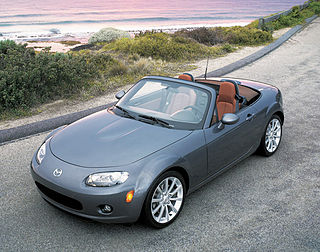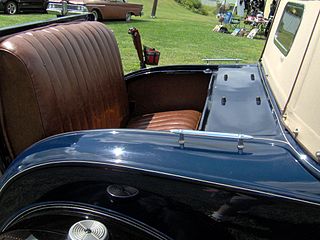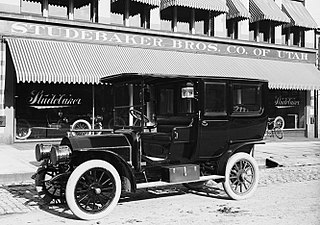
A convertible or cabriolet is a passenger car that can be driven with or without a roof in place. The methods of retracting and storing the roof vary among eras and manufacturers.

A coupe or coupé is a passenger car with a sloping or truncated rear roofline and two doors.

A carriage is a private four-wheeled vehicle for people and is most commonly horse-drawn. Second-hand private carriages were common public transport, the equivalent of modern cars used as taxis. Carriage suspensions are by leather strapping and, on those made in recent centuries, steel springs. Two-wheeled carriages are informal and usually owner-driven.

A sedan or saloon is a passenger car in a three-box configuration with separate compartments for an engine, passengers, and cargo. The first recorded use of sedan in reference to an automobile body occurred in 1912. The name derives from the 17th-century litter known as a sedan chair, a one-person enclosed box with windows and carried by porters. Variations of the sedan style include the close-coupled sedan, club sedan, convertible sedan, fastback sedan, hardtop sedan, notchback sedan, and sedanet/sedanette.

Coupé de ville — also known as town car or sedanca de ville — is a car body style produced from 1908 to 1939 with an external or open-topped driver's position and an enclosed compartment for passengers. Although the different terms may have once had specific meanings for certain car manufacturers or countries, the terms are often used interchangeably.
There are many types of car body styles. They vary depending on intended use, market position, location, and the era they were made in.
A jockstrap, also a jock (male), jill (female), strap, cup, groin guard, pelvic protector (female), supporter, or athletic supporter, is an undergarment for protecting the testes and penis or vulva during contact sports or other vigorous physical activity. This article deals chiefly with the genital protective sports gear designed for the male body, colloquially known as a "jock".
Landau is a carriage design with a folding fabric top consisting of two sections supported by external elliptical springs.

A berlinetta is a sports coupé, typically with two seats but also including 2+2 cars. The original meaning for berlinetta in Italian is “little saloon”. Introduced in the 1930s, the term was popularised by Ferrari in the 1950s. Maserati, Opel, Alfa Romeo, and other European car manufacturers have also used the Berlinetta label. In America, Chevrolet also produced a version of the Camaro called the Berlinetta, from 1979 to 1986. The Berlinetta model was marketed as having a luxury focus, through interior features and softer suspension.

A brougham was a light, four-wheeled horse-drawn carriage built in the 19th century. It was named after the politician and jurist Lord Brougham, who had this type of carriage built to his specification by London coachbuilder Robinson & Cook in 1838 or 1839. It had an enclosed body with two doors, like the rear section of a coach; it sat two, sometimes with an extra pair of fold-away seats in the front corners, and with a box seat in front for the driver and a footman or passenger. Unlike a coach, the carriage had a glazed front window, so that the occupants could see forward. The forewheels were capable of turning sharply. A variant, called a brougham-landaulet, had a top collapsible from the rear doors backward.

A runabout is a car body style popular in the 1910s, based on the horse-drawn runabout carriage.

A barouche is a large, open, four-wheeled carriage, both heavy and luxurious, drawn by two horses. It was fashionable throughout the 19th century. Its body provides seats for four passengers, two back-seat passengers vis-à-vis two behind the coachman's high box-seat. A leather roof can be raised to give back-seat passengers some protection from the weather.

A chaise, sometimes called chay or shay, is a light two- or four-wheeled traveling or pleasure carriage for one or two people with a folding hood or calash top. The name, in use in England before 1700, came from the French word "chaise" through a transference from a sedan-chair to a wheeled vehicle.

A rumble seat, dicky (dickie/dickey) seat, also called a mother-in-law seat, is an upholstered exterior seat which folded into the rear of a coach, carriage, or early motorcar. Depending on its configuration, it provided exposed seating for one or two passengers.

The chariot that evolved from the ancient vehicle of this name took on two main forms:

A coach is a large, closed, four-wheeled, passenger-carrying vehicle or carriage usually drawn by two or more horses controlled by a coachman, a postilion, or both. A coach has doors in its sides and a front and a back seat inside. The driver has a raised seat in front of the carriage to allow better vision. It is often called a box, box seat, or coach box. There are many of types of coaches depending on the vehicle's purpose.

A vis-à-vis is a carriage in which the passengers sit face to face with the front passengers facing rearward and the rear passengers facing forward. The term comes from the French vis-à-vis, meaning face to face.

A brougham was originally a car body style where the driver sat outside and passengers seated within an enclosed cabin, as per the earlier brougham horse-drawn carriage. Similar in style to the later town car, the brougham style was used on chauffeur-driven petrol and electric cars.

A limousine, or limo for short, is a large, chauffeur-driven luxury vehicle with a partition between the driver compartment and the passenger compartment which can be operated mechanically by hand or by a button electronically. A luxury sedan with a very long wheelbase and driven by a professional driver is called a stretch limousine.

The Concord coach is a type of horse-drawn coach, often used as stagecoaches, mailcoaches, and hotel coaches. The term was first used for the coaches built by coach-builder J. Stephen Abbot and wheelwright Lewis Downing of the Abbot-Downing Company in Concord, New Hampshire, but later to be sometimes used generically. Like their predecessors, the Concords employed a style of suspension and construction particularly suited to North America's early 19th century roads. Leather thoroughbraces suspend passengers who are in constant motion while the coach is moving. The swaying is accepted by passengers for the shock absorbing action of the leather straps and for the way the special motion eases the coach over very rough patches of roadway. This suspension, which was developed by Philip de Chiese in the 17th century, was long replaced by steel springs in England.



















